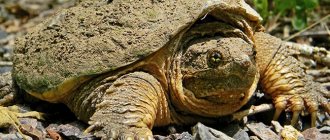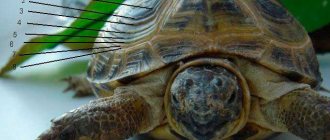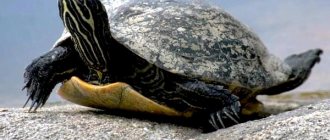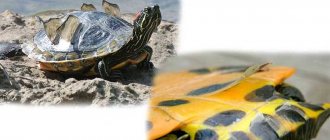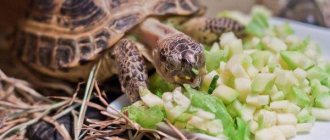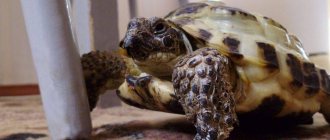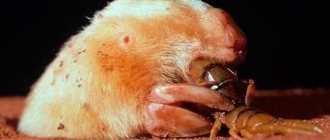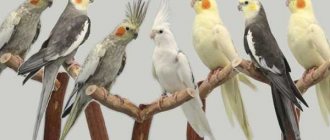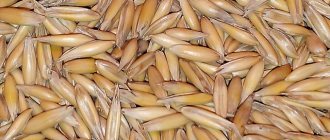- How long do turtles live?
Everyone associates turtles with the eternal slowness characteristic of these reptiles, but not everyone knows that turtles are one of the most ancient representatives of the animal world of our planet. These creatures have been living on Earth for more than 220 million years, yes, they are the same age as extinct dinosaurs. The very name of the word “turtle” comes from the ancient Slavic “shovel”, “tile”, and the Latin name for the turtle is similar – “testa” is translated as “tile”, obviously, the turtles were nicknamed this way due to the similarity of their shells with the tiles themselves.
Description, structure, characteristics
Carapace
Perhaps it is the shell of a turtle that is its most characteristic difference, a kind of turtle calling card. For a turtle, it is, in fact, a sort of mobile home + a means of protection from enemies. The turtle shell consists of a dorsal (carapace) and abdominal (plastron) part. The carapace, in turn, consists of two parts, one of which is the internal armor, formed from bone plates, and the second is the outer part, consisting of horny scutes. In some species of turtles, the bony plates are covered with skin.
The shell of a turtle is very durable, so it can easily withstand a load exceeding the weight of the turtle itself by 200 times.
Size
The size of a turtle and its weight differ greatly from the species, so in the turtle family there are both giant turtles with a weight of more than 900 kg and a shell size of 2.5 meters or more, and small turtles with a weight of up to 125 grams and a shell size no more than 10 cm.
Head and eyes
The turtle's head is streamlined and medium in size. Such dimensions allow turtles, in case of danger, to quickly hide their heads inside an inaccessible shell. Although among them there are also species with large heads that either fit poorly in the shell or do not fit at all.
In land turtles, the eyes are usually directed towards the ground, while in aquatic turtles they are located closer to the top of the head and point forward and upward. The neck of many turtles is usually short.
The vision of turtles is well developed, even moreover, turtles, like people, have color vision and can distinguish colors, a gift that very few animals have. Nature also gave them excellent hearing, allowing them to hear potential enemies from a distance.
Does a turtle have teeth? How many teeth does a turtle have?
Modern turtles, unfortunately, do not have teeth, but ancient turtles had them, those that lived during the era of dinosaurs, but over time they disappeared. Then how does a turtle eat? To bite and grind food, turtles use a strong beak; the surface of this beak is covered with rough protuberances, which practically replace teeth for turtles. The tongue of turtles is short; it serves exclusively for swallowing food, but not for capturing it, and as a result, does not protrude outward.
Limbs and tails
All turtles, without exception, have four legs. But the very structure of these paws depends on the type and habitat of the turtle. The paws of land turtles have a flattened shape, they are adapted for digging soil and are quite powerful. In the process of millions of years of evolution, sea turtles' paws have turned into real flippers for the convenience of swimming in the depths of the sea.
Also, almost all turtles have a tail. The tail of a turtle, like its head, is also capable of hiding in its shell. Moreover, what is interesting is that some turtles have a real pointed spike at the tip of their tail, which serves as another means of protection from enemies.
An interesting fact: some land turtles can molt with age, and their old skin peels off and falls off, both from the paws and sometimes from the shell.
Lifespan
Turtles are truly long-lived even by our human standards, because they live many times longer than us humans. So the average life expectancy of turtles in natural conditions can be 180-250 years.
The oldest turtle in the world, named Jonathan, lives on the island of St. Helena and remembers (probably) the times of Napoleon, because the former emperor of France lived here in exile for some time.
Wintering
Another method is cooling. Reptiles are placed one at a time in cloth bags and placed in sphagnum moss. Boxes with turtles should be taken to a cool room (from 0 to 12 degrees). To prevent dehydration, the filler should be sprayed with water from a spray bottle every day. As a rule, artificial wintering lasts about four weeks. The turtle boxes can then be moved back into the house. After two days, the animals can be placed in a terrarium and a heat lamp can be turned on, thereby increasing the duration of daylight hours to 16 hours. It is very important to include foods rich in vitamin E in your pet’s diet.
Habitats
Turtles live in all tropical areas, as well as some places with temperate climates. Sea turtles swim in the warm ocean spaces of the Pacific, Atlantic and Indian Oceans. They are not found only near the Arctic and
Antarctica, which is natural, because all turtles love warmth.
Land turtles live in the steppes and semi-deserts of Africa, South and North America, Australia, and Asia. In Europe they can be found in the south, in a number of southern countries: Greece, Italy, Albania.
Pregnancy period
After mating, individuals should be immediately placed in separate terrariums. The fact is that after intercourse, males often show aggression. So, let's continue to look at how turtles reproduce. The female bears the eggs for about two to three months. During this period she behaves restlessly. Experienced zoologists recommend including fresh foods rich in vitamins in her diet. The temperature in the terrarium must be maintained within 22–26 degrees Celsius. And on land you should prepare a separate place for laying eggs. To do this, dig a hole in the soil or sand and place a small container with sphagnum moss there so that it is level with the land. After laying eggs, the female forgets about her offspring.
Nutrition
The diet of turtles directly depends on their species, habitat and lifestyle. Land turtles are practically vegetarians; their main food is tree branches, fruits and grass, mushrooms and vegetables. However, it was not in vain that we wrote practically, since in order to maintain the protein balance in their bodies, turtles can sometimes eat various small animals such as snails, slugs and worms. Land turtles also drink water with pleasure.
But sea and freshwater turtles are already real predators, since their diet includes various small fish,
frogs, snails, crustaceans (some sea turtles happily eat squid, cuttlefish and other shrimp). But the gastronomic preferences of aquatic turtles are not limited to living creatures; along with them, they also eat plant foods: algae.
Interesting fact, there are species of sea turtles that eat poisonous jellyfish. From such food, the meat of the turtles themselves, in turn, becomes poisonous, which scares potential predators away from them. This is a gastronomic remedy.
Newborn care
Baby turtles hatch from eggs using a tooth located on the tip of their nose. With this small fang they pierce the shell from the inside. Two days after hatching, the tooth disappears on its own. All young individuals have a transverse fold on the plastron, associated with the position of the reptiles in the egg. Under no circumstances should baby turtles be placed in the same pen as adult animals. The fact is that mature individuals lack maternal instinct, and therefore they can cause irreparable harm to the young. Newly hatched offspring are usually kept under the same temperature conditions as adults. Their diet should consist primarily of plant foods with added calcium. The bottom of the terrarium should be covered with special soil intended for a specific type of reptile.
Enemies in nature
Speaking of enemies, in natural conditions the main enemies of a turtle are some birds of prey (eagles,
hawks), which grab small turtles, lift them to a great height, from there they throw them onto stones and peck out their entrails from their broken shells.
Interesting fact: the great ancient Greek playwright Aeschylus died an extremely ridiculous death, he was killed by a turtle that fell on his head. The eagle, having lifted the turtle to a height, mistakenly considered the playwright's bald head to be a large stone suitable for breaking the turtle's shell.
Death of Aeschylus by an eagle and a turtle.
As for giant turtles, given their weight and size, they have no enemies in nature. Even people are increasingly treating these majestic, long-lived creatures with due respect.
Incubation period
As soon as the female lays eggs, the container should be removed from the terrarium and placed in an incubator. It is recommended to isolate the young mother from other reptiles for some time. At the same time, her nutrition should be enhanced for two to three weeks. This will restore the animal’s strength and immunity. The temperature in the incubator where the eggs are located should be maintained within 29 degrees. The height of the sand in it should be at least 20 centimeters. You also need to place a small vessel with water there, placing it under a heating lamp.
You can use a simple aquarium or glass jar as an incubator. Turtle eggs should not be turned. They should be handled with extreme caution. After three months, babies will hatch from the eggs. Young offspring should be immediately transplanted into an aquarium or aquaterrarium. Please remember that some eggs may not be fertilized.
Hibernation
Yes, turtles, like
Bears and some other animals tend to hibernate, during which all life processes in their body slow down for a while. This usually happens in winter, and hibernation for heat-loving turtles living in temperate latitudes allows them to survive the winter cold without problems.
How to determine gender
The gender difference in turtles is so weakly expressed in appearance that it is sometimes difficult to determine whether this turtle is a “boy” or a “girl.” However, if you approach this issue with due attention, you can identify a number of signs that help determine the sex of a turtle.
1. Shell; in females the shell has a more elongated shape than in males.
2. Plastron, also known as the lower part of the shell. If you turn the turtle over, you can see that in females the lower part of the shell (the one closest to the anus) is flat, while in males it is slightly concave.
3. Tail, males have a tail that is longer and wider at the base, while “lady turtles” have a straight and short tail.
4. Claws, in males they are usually longer on the forelimbs than in females.
Selection of breeding material
When breeding exotic animals, take care of the health of the offspring. It is important to select healthy, mature female and male turtles of the same species and subspecies. Use turtles from different breeding lines; possible inbreeding increases the risk of producing genetically deformed offspring.
If mating occurs between different species/subspecies, the eggs may be infertile, or the subsequent offspring may be so. This practice is discouraged as it leads to the destruction of the species.
Types, photos and names
The turtle family is divided into two suborders, divided by the way turtles retract their heads into their shells:
Also, according to their habitat, all turtles are divided into land and sea turtles, which in turn are divided into freshwater turtles, living in rivers and lakes, and marine turtles, living in the seas and oceans.
Below we take a closer look at some of the most interesting turtle species.
Galapagos tortoise
She's the same
elephant turtle. These are real giant tortoises, the weight of a Galapagos tortoise can exceed 400 kg, the length of the shell reaches up to 1.9 m. These tortoises live on the Galapagos Islands, which gave them their name.
Egyptian tortoise
This is already a small representative of land turtles, the length of the Egyptian tortoise shell is no more than 10 cm. They have a yellow-brown color of the shell. This turtle lives in northern Africa and the Middle East.
Central Asian tortoise
This is a small turtle that lives in Asia, has a rounded shell and is colored yellow-brown with dark spots. The average size of the shell of this turtle is 10 cm. It is also one of the most popular types of turtles for home keeping.
Leopard tortoise
She's the same
panther turtle. It is of medium size, the length of the shell is 0.7 m, with a weight of up to 50 kg. The shell of this turtle is high and dome-shaped. The pattern of the shell shows a spotted pattern, similar to the color of a leopard. The leopard tortoise lives in Africa.
Cape spotted turtle
It is notable for being the smallest turtle in the world. The length of its shell is no more than 10 cm, with a weight of up to 165 grams. Lives in South Africa.
Chelydridae
(snapping turtles). The family includes only 2 species, of which the best known is the snapping turtle (Chelydra serpentina). It is an aquatic reptile native to much of North America and northwestern South America, abundant in southeastern Canada and the eastern half of the United States, where it is highly prized as a food item. Snapping turtles are unfairly blamed for killing large numbers of fish and waterfowl. The weight of these animals often reaches 13.6 kg. When pulled out of the water, they can bite painfully.
Another species, the snapping turtle (Macrochelys temmincki) is one of the giants of the order, reaching a mass of approx. 90 kg. Not only are they the heaviest of its freshwater species, but they are also the most water-bound of the North American turtles. They are found in the southeastern United States, mainly in the lower Mississippi. Being slow, the snapping turtle lures prey with the help of a fleshy outgrowth of the bottom of the mouth, which moves in its open mouth like a worm.
Types of freshwater turtles
Painted turtle
This small turtle lives in waters of the USA and Canada. It has an interesting olive-green or black shell color and leathery membranes between the toes.
European marsh turtle
This small turtle lives in the waters of Europe and a number of Asian countries; the length of its shell is 35 cm and its weight is 1.5 kg. It has a brown-brown or olive-colored shell, and also a very long tail, like for a turtle.
Pond slider
So named due to the presence of a bright red spot on the head. The length of the shell of this turtle is 30 cm. Red-eared turtles live in both Americas, in the USA, Mexico, Colombia, Venezuela and several other countries.
snapping turtle
Its characteristic feature is the presence of a cross-shaped plastron and a long tail covered with small spines. It is of medium size, the weight of this turtle reaches up to 30 kg. It lives in the USA and southern Canada; it survives the winter cold in hibernation.
Emydidae
(freshwater turtles). This is the largest family of the order, uniting more than a third of all its species. They are common to the northern continents, also found in northern South America and Africa and are very diverse in size and body shape.
The painted turtle (Chrysemys picta), which is distributed throughout the United States, is one of the most famous members of the family. It often reaches high numbers even in small ponds. Box turtles (Terrapene) are also a common genus, but are not found in the western United States. They are mostly land animals; the movable elements of the plastron enable them to tightly close all the openings of the shell, like flaps. Ornamented turtles (Pseudemys) inhabit the southeastern United States.
Types of sea turtles
Hawksbill turtle
She's a real carriage. The shell of this turtle is painted in brown tones with a pattern of multi-colored spots. The front flippers of this turtle are equipped with two claws. This turtle lives in almost all oceans, with the exception of cold waters near the poles.
Leatherback turtle
Notable for being the largest turtle in the world. Only the span of its front flipper-like paws reaches 2.5 meters. Its weight is more than 900 kg, and its shell length exceeds 2.6 meters. The surface of this turtle's shell is covered with a dense layer of skin (hence the name). It lives in tropical regions of the Indian, Atlantic and Pacific oceans.
Green turtle
It is also a fairly large turtle, its weight reaches up to 450 kg with a shell length of 1.5 m. It has an olive or green shell color, which, however, may have white stripes and dark spots. Its shell is small in height and oval in shape, and its surface is covered with large horny scutes. The head of this turtle is much larger than that of other relatives, and therefore does not hide inside the shell. It lives in tropical areas of the Atlantic and Pacific oceans.
Dermochelyidae
(leatherback turtles). The leatherback turtle (Dermochelys coriacea) is the only living species of this family. This giant can reach a mass of more than 680 kg with a front flipper span of 3.6 m. The leathery shell bears 7 longitudinal ridges on the dorsal side and 5 on the ventral side. Although the range of these turtles covers all warm oceans, they are the rarest among the widespread marine species of the order. The question of the systematic position of the group remains controversial. It was allocated to a special suborder Athecae (scutellae), but most experts agree only on the rank of superfamily.
Reproduction
The mating season for turtles occurs at different times depending on the species. However, in all turtles it occurs in a similar way: the males stage real battles for the right to mate with the female. How do turtles fight? It’s very simple, the land ones try to turn the enemy over with a blow from their shell, and the water ones hit and bite each other with their beaks. Only after driving away a potential rival does the male turtle begin courting his “lady,” forcing her to take a position convenient for the actual mating.
Some time after mating, the female turtle lays spherical or ellipsoidal eggs, from which small turtles will be born. Turtles dig special holes for their eggs, and sometimes even use the nests of crocodiles.
From 1 to 200 eggs can be laid at a time (depending on the species). Also, the duration of the incubation period can last from 2 months to six months or more.
After hatching, small turtles begin to struggle for survival; not all of them will survive to adulthood; young turtles are an excellent target for various predators, especially birds of prey.
Breeding problems
Any turtle breeder faces breeding problems. The most common mistakes are:
unfertilized eggs. In the absence of males, turtles lay “empty” eggs. Only after copulation does conception and successful laying occur;
failure to maintain humidity and correct air temperature in the terrarium;
the absence of mating games negatively affects the interest of males in young females. The partner must win the female, become the winner and receive the desired prize;
a poor diet and lack of vitamins also negatively affect the offspring.
Keeping at home
Keeping turtles at home has recently become very popular, both land and aquatic turtles are kept. And why not, because caring for them is extremely simple, and turtles themselves are unpretentious creatures. True, all of the above is true for small turtles, since keeping large turtles in the house will not be entirely appropriate.
So, what are the rules for caring for turtles? First, in the turtle's habitat, you need to keep a thermometer to monitor the air temperature and a thermometer to monitor the water temperature (if it is an aquatic turtle in an aquarium).
The water in an aquarium for turtles must either be purified using filters, or if there are none, then changed every day. Maintaining hygiene for aquatic turtles involves removing algae from their shells. But land turtles need to be bathed daily in warm water, washing away dirt and food debris. Also, in winter, it is advisable to irradiate turtles a little with the rays of a quartz lamp, thus creating a kind of sunbathing.
Terrarium
Some believe that you can keep a reptile in a regular cardboard box. It's a delusion. In order for your pet to feel as comfortable as possible, he needs to create all the necessary conditions. For these purposes, only a terrarium with high walls (about 1 meter) can be suitable. You should pour fairly coarse sand at the bottom, and make a small canopy out of fabric or cardboard in the corner. Such living conditions are the most natural for these animals. The terrarium must be equipped with heating, ventilation and lighting systems. Since many species of turtles require ultraviolet radiation, it is recommended to install UV lamps along with conventional lamps. They should be placed at a distance of at least 60 centimeters from the location of the reptile. Small ventilation holes should be made in the walls and on the lid of the terrarium. For aquatic turtles, you need to build a small pond at the same level as the floor. It is very useful to place young individuals of freshwater species in an aquarium with water for some time. It should be regularly replaced with fresh, settled one.
What to feed at home
Turtles need to be provided with a balanced diet. Can you feed land turtles?
leaves of cabbage, dandelion, pulp of apples, cucumbers, tomatoes. To meet the need for protein food, they can be given boiled chicken eggs and vitamin supplements.
Feeding aquatic turtles will be a little more difficult, because they need small animals; you can feed them with dried daphnia, bloodworms, earthworms, boiled chicken or beef. They will not mind eating various insects, cockroaches, and small aquarium fish.
Adult turtles need to be fed once a day, young turtles twice a day and a so-called fasting day once a week.
Interesting Facts
- It was turtles that were the first to fly around our moon, on board an experimental research probe launched by the Soviet Union back in 1968.
- Turtle meat is an expensive and delicious product in some cuisines around the world.
- Turtles are also present in heraldry, in the depiction of the coats of arms of some cities.
- Despite the fact that turtles do not pose a danger to humans, there are exceptions, for example, male leatherback turtles can confuse a swimmer with a female, grab them with their paws and drag them to the bottom.
- The sex of turtles in the egg is determined by the ambient temperature. At lower temperatures, males are born, at higher temperatures, females are born.
Stressful situations
If the male is too active, he can injure the female, so you should not keep him nearby all the time. The turtle also needs distance from the male to successfully lay eggs. In a tense state, she can retain eggs, which will lead to serious complications. In captivity, despite all attempts, the female cannot independently hide from the persistent advances of her partner; for this reason, many breeders do not keep adult males and females together, placing them only for mating purposes.
Video
And finally, here is an interesting documentary about turtles.
Author: Pavel Chaika, editor-in-chief of Poznavaika magazine
When writing the article, I tried to make it as interesting, useful and high-quality as possible. I would be grateful for any feedback and constructive criticism in the form of comments on the article. You can also write your wish/question/suggestion to my email [email protected] or Facebook, with respect, the author.
Author page
